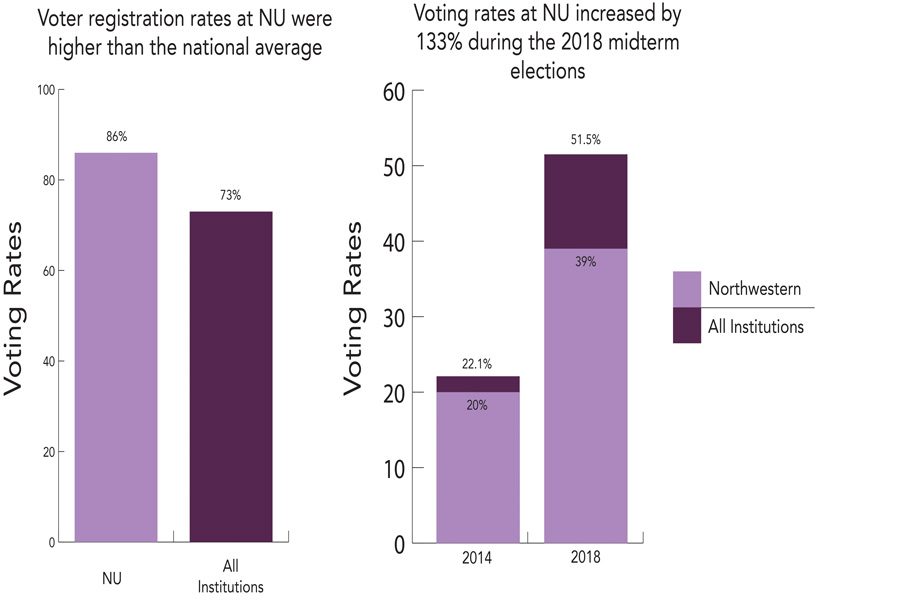Northwestern voting participation rate more than doubled in 2018 midterm elections
October 30, 2019
Northwestern’s student voting participation rate more than doubled in the 2018 midterm elections, showing an increase from 2014’s 22.1 percent to 51.5 percent, according to a University release.
Though the average voter participation rate at other institutions also increased significantly — from 19.7 percent to 39.1 percent — Northwestern’s dramatic uptick outpaced most of the 1,000-plus U.S. colleges and universities surveyed.
The National Study of Learning, Voting, and Engagement was conducted by the Institute for Democracy and Higher Education at Tufts University. Of the 14,896 eligible undergraduate, graduate and professional studies students enrolled at Northwestern in 2018, the study showed that 12,802 — or 86 percent — registered to vote. That also eclipsed the national average of 73 percent.
Robert Donahue, acting director of Northwestern’s Center for Civic Engagement, said the center has been working towards creating a “new cultural norm” of voting upon entering college by integrating voter registration into orientation for all students.
The center, in addition to encouraging undergraduate voter registration, launched several initiatives in 2018 that contributed to increased civic engagement on campus.
One of those was the Student Ambassadors Program. In 2018, the center began training students to register people to vote. Student ambassadors also worked with residential halls and student groups to host events like “ballot parties,” where people could learn more about candidates and discuss how they would cast their ballot.
This year, for the first time, the center also integrated voter registration into orientation for graduate students, which helped over 97 percent of graduate students who are eligible voters register, he said. Simply making the opportunity to vote more accessible for students has led to what Donahue called promising rises in registration numbers.
“It’s so important for our democracy,” Donahue said, “that young people get registered and get involved in learn(ing) how to educate themselves and learn how to vote responsibly.”
Weinberg sophomore Abigail Roston said defining national events, such as Brett Kavanaugh’s Supreme Court nomination, also helped students who were marginally engaged in politics realize the importance of voting and catalyzed the sharp increase in participation rates.
“In everyday conversation, the Kavanaugh hearings come up pretty frequently as moments that pushed people of our generation to realize the influence they have in the political landscape,” Roston said, “especially for those who identify as female on campus.”
Cameron Peters, press secretary of NU College Democrats, said he was happy to see the excitement surrounding the midterm elections translated into people showing up at the polls.
“We’re excited to bring the (vote participation rate) even higher and higher in 2020,” the Medill third year said.
Others believed Northwestern students were fueled by the change in the White House. Secretary of events for NU College Republicans Max Tokman, for example, said the student body — which is predominantly liberal — was propelled into action after President Donald Trump took office in 2016.
“There’s just a bigger wave now of more college students getting out and involved in politics because of the election,” Tokman said.
In October 2017, Northwestern received five awards at the ALL IN Challenge Award Ceremony, a ceremony to honor outstanding contributions to improving college democratic engagement. Northwestern was awarded highest voting rate among large, private 4-year institutions and most improved voting rate in the same category. Northwestern also received the standout administrator award honoring Donahue.
Donahue said the center, in addition to registering Northwestern students, helps integrate institutional knowledge to assist student ambassadors in navigating voting procedures across all 50 states to help students register correctly and responsibly.
The center plans to continue using the student ambassador model after seeing great interest among students for the role, Donahue said.
“The students are really the ones who are out there running events, meeting with people, working the tables,” Donahue said. “I think they’ll come up with even more creative things to do going into 2020.”
Email: jamespollard2022@u.northwestern.edu
Twitter: @pamesjollard
Email: amyli2021@u.northwestern.edu



